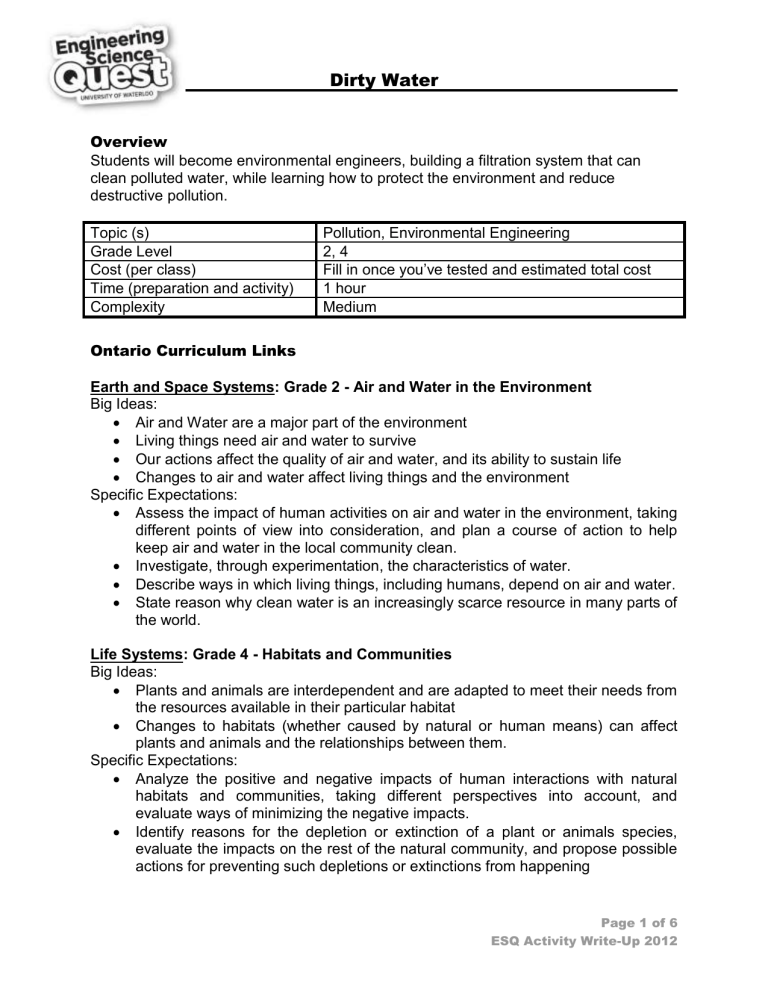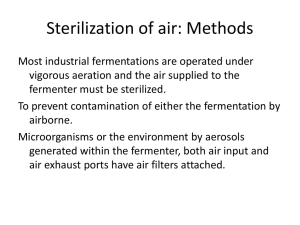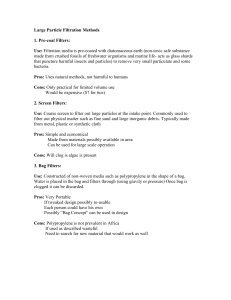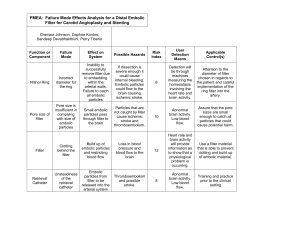Per Group of 3

Dirty Water
Overview
Students will become environmental engineers, building a filtration system that can clean polluted water, while learning how to protect the environment and reduce destructive pollution.
Topic (s)
Grade Level
Cost (per class)
Pollution, Environmental Engineering
2, 4
Fill in once you’ve tested and estimated total cost
Time (preparation and activity) 1 hour
Medium Complexity
Ontario Curriculum Links
Earth and Space Systems: Grade 2 - Air and Water in the Environment
Big Ideas:
Air and Water are a major part of the environment
Living things need air and water to survive
Our actions affect the quality of air and water, and its ability to sustain life
Changes to air and water affect living things and the environment
Specific Expectations:
Assess the impact of human activities on air and water in the environment, taking different points of view into consideration, and plan a course of action to help keep air and water in the local community clean.
Investigate, through experimentation, the characteristics of water.
Describe ways in which living things, including humans, depend on air and water.
State reason why clean water is an increasingly scarce resource in many parts of the world.
Life Systems: Grade 4 - Habitats and Communities
Big Ideas:
Plants and animals are interdependent and are adapted to meet their needs from the resources available in their particular habitat
Changes to habitats (whether caused by natural or human means) can affect plants and animals and the relationships between them.
Specific Expectations:
Analyze the positive and negative impacts of human interactions with natural habitats and communities, taking different perspectives into account, and evaluate ways of minimizing the negative impacts.
Identify reasons for the depletion or extinction of a plant or animals species, evaluate the impacts on the rest of the natural community, and propose possible actions for preventing such depletions or extinctions from happening
Page 1 of 6
ESQ Activity Write-Up 2012
Dirty Water
Describe ways in which humans are dependent on natural habitats and communities
Theory & Background Information
WATER POLLUTION : 71% of the earth is covered in water. The water covering the earth is in both liquid and solid/frozen form. The remaining 29% of earth is the land that we live on. Water is extremely important to us. It is essential for life. We use it in our foods, in the production of many materials, in cleaning, in recreation, and of course for drinking. Despite this need, only a very small portion of the water on earth is useful to us. Almost all of the water on earth is saltwater found in the oceans. This water is not a safe form of water to drink. The small remaining form of water is fresh water, which is safe for drinking. Fresh water however, is mostly frozen in glaciers and ice caps and as a result is not easily accessible to us. A very small percentage of fresh water is available for us to use as a drinking source. This small portion of drinking water is quickly deteriorating because of pollution from many sources.
FILTRATION : A filter prevents that passage of certain particles in a solution, while allowing the transport of other particles in the solution. The residue consists of the particles that are not able to pass through the filter. The filtrate consists of the particles of the solution that are able to travel through the filter. The passage of particles through a filtration system is dependent on the filter as well as the size of the particles. A coffee filter for example is made up of very small holes that can only be seen under a microscope. The size of holes in the filter determines which particles can pass through.
If the particles in the solution are larger than the holes of the filter, the particles will remain on top of the filter (the residue). Particles that are smaller than the holes in the filter are able to pass through the filter (the filtrate).
Other particles such as gravel and sand can also serve as filters. When gravel is sitting in a funnel, the pebbles are resting next to each other; however there are spaces between these pebbles. When a solution is passed through the gravel filter, particles that are bigger than the spaces between the gravel pebbles cannot filter through. The particles in the solution that are smaller than the spaces found between the pebbles of gravel will be able to travel through the gravel filter. If sand was used as a filter in place of the gravel, even smaller particles could be trapped since the spaces between sand grains are much smaller than the spaces found between the gravel pebbles. Charcoal, a very fine powder, is a common ingredient in filters as well. Charcoal has small pores that act to trap dirt and impurities. Due to the messiness of charcoal, it will not be used in this activity. There are several other types of materials that also work as filters such as screens, cheesecloth, paper towels, and cotton balls.
While many of these examples of filters are useful on their own, a very effective filter can be constructed when several individual filters are layered in combination. For
Page 2 of 6
ESQ Activity Write-Up 2012
Dirty Water instance, sand can be layered on top of a coffee filter. Gravel pebbles can then be laid on top of the sand layer. When a sample of water containing unwanted particles is poured into this combination filter, the very larger particles that are bigger than the spaces found between the pebbles in the gravel layer will be stopped. Medium particles will be stopped in the middle sand layer. Small particles will be trapped by the coffee filter. These three sized (large, medium and small) particles form the residue. The desired water will be able to travel through the coffee filter and will leave the filter as the filtrate. Some students might question why a single coffee filter is not used seeing as it will be able to stop the large, medium, and small particles . If just a coffee filter was used there is a good chance that the large and medium particles will clog the filter and block the passage of any possible filtrate (the water). The filter would not allow for any separation of the unwanted particles and the desired water.
Microorganisms and dissolved chemicals are unfortunately not stopped in the filtration system. These microscopic organisms and chemical molecules are too small to be trapped by the filters and instead remain in the filtrate. Due to this, the filtered water is still not safe and requires the addition of chemicals that can kill microorganisms and neutralize chemical toxins.
Environmental engineers design and build things that help solve environmental problems, such as filtration systems.
Materials
Per Class
the story of Beaver Bay (attached at the end of activity)
labeled Ziploc bags containing the pollutants (see below)
large jar (to contain Beaver Bay)
bucket of sand
bucket of gravel
container of charcoal
box of coffee filters
screen squares
cotton balls
cheese cloth
paper towel
masking tape
plastic table cloth
Jug with a spout (used to pour polluted water into the students filtration systems)
Per Group of 3
bottle/funnel combination – a water/pop bottle with the top cut off and then inverted into the bottom of the bottle.
$500 ESQ dollars
Page 3 of 6
ESQ Activity Write-Up 2012
Dirty Water
labeled Ziploc bags
Contents What it Represents
Label
River
Salt Marshes
Shellfish
Settlers
Gold Rush
Farmers
Fishermen
Houses
Laundromats
Port
Factories
Bacteria
Residents
Oil Change
Procedure
Sand
Dry grass
Crushed shells
Organic garbage
Potting soil
Potting soil
Fishing line
Toilet paper
Laundry detergent
Vegetable oil
Food colouring
Food colouring
Soapy water
Vegetable oil
Sand/sediment
Decomposed plants
Crushed shells
Organic garbage
Sediment containing mercury
Soil erosion from farming
Littered fishing line
Sewage prior to advanced wastewater treatment
Sewage prior to advanced wastewater
Treatment
Oil leaks from tankers
Industrial water pollution
Bacteria
Washing a car in street
Dumping of used motor oil
Preparations
1. Gather and prepare listed materials.
2. Prepare the Ziploc bags for the story of Beaver Bay.
3. Prepare the filter model demonstration (template and directions attached).
4. Create the gravel and sand filter posters (template attached).
Introduction
□ Discuss water pollution with the students
□ Explain to the students that most of the ear th’s surface is made from water.
□ Describe to the students the two types of water – salt and fresh.
Explain that most of the water on the earth is salt water - not safe to drink.
Demonstrate this by asking anyone if they have ever had a stomach ache when they have swallowed too much salt water when swimming in the ocean.
Only a small amount of water on the earth is fresh water that we can drink.
There are two problems with this:
Most is trapped in glaciers and icecaps.
Quickly becoming polluted.
Ask the students
“How does water become polluted?
□ Read the story to the class, emptying the contents of the Ziploc bags into the
Beaver Bay jar at the appropriate time in the story.
□ Periodically ask student if they would swim in Beaver Bay. Would they eat fish that was caught from the Bay?
□ When the story is finished, ask the students who dirtied the water in the story.
Stress that everyone in the Beaver Bay community has played a role in polluting the water.
□ Ask students who is responsible for polluting our bodies of water .
Page 4 of 6
ESQ Activity Write-Up 2012
Dirty Water
□ Ask students whose responsibility it is to clean polluted water . Lead the students to realize that we are all responsible for this pollution
□ Explain what Environmental engineers do.
□ Introduce the use of filtration systems to the students.
A filter is a barrier that allows the passage of some materials, while preventing the passage of others.
All filters have holes . Their size determines which particles travel through.
The items that pass through the filter are called the filtrate . The items that are held back are called the residue .
□ Describe to the students how particles (gravel and sand) can be used as filters.
□ Explain to the students that there are several other types of materials that also work as filters such as screens, cheesecloth, paper towels, and cotton balls.
Activity
□ Introduce the challenge to the students:
□ Students will work as environmental engineers to build a filtration system to clean a sample of Beaver Bay water and collect the most amount of clean water.
□ Divide students into groups of two.
□ Explain steps:
Place the bottle top upside down into the bottle bottom. To make a funnel.
Lay the coffee filter inside the bottle top funnel.
Pour the sand contents into the coffee filter.
Pour the gravel contents onto the sand layer.
□ Test each filtration system: pour an equal amount of Beaver Bay water into each.
□ Discuss with the students what worked and what did not work well
□ Explain to the students why the water may look clear, but it is still coloured.
The filtrates from all of the filtration systems will remain coloured. Remind the students that the water became coloured from the dumping of dangerous bacteria and chemical toxins.
Explain to the students that bacteria and dissolved chemicals are too small to be stopped by most filters. Chemicals that kill the bacteria must be added to eliminate these organisms.
Activity Accommodations and Extensions
Accommodations
If time permits, students could participate in the story by adding the pollutants to
Beaver Bay instead of the instructor.
Extensions
The story should be presented more factual as the age increases.
Resources
Page 5 of 6
ESQ Activity Write-Up 2012
Dirty Water
www.evols.org/pdfs/dirtywater.pdf
Water Filtration - Eureka Project Book ’98
The Wonderful Water Purifier - Science Quest Project Book ’91
Geological Engineering – Ground Water Workshop (ESQ) 2000
Page 6 of 6
ESQ Activity Write-Up 2012








